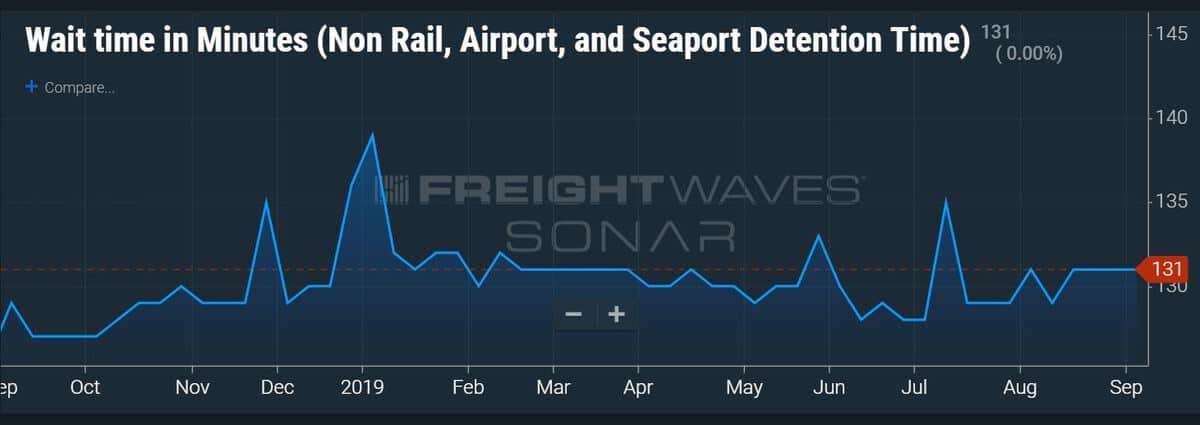Longer waits to load and unload freight continue to vex truckers, especially women drivers less likely to complain about being kept waiting, according to new survey data from the American Transportation Research Institute.
Both the length and frequency of detention — the number of average minutes a truck spends inside a shipper or receiver location for unloading and loading — have increased over the last four years, ATRI reported Sept. 4. The analysis was based on more than 1,900 driver and motor carrier surveys conducted in 2014 and 2018.
Delays of two or more hours increased 11.2% between 2014 and 2018, with delays of six or more hours rising 27.4%.
Nearly 40% of drivers who completed surveys at major trucking shows in Louisville, KY, and Dallas in 2018 reported that seven of 10 of their pickups and deliveries were delayed by customer actions over the past 12 months.
FreightWaves SONAR data (WAIT.TRUCK) shows trucking wait times averaging 131 minutes – just over two hours — nationally so far in September.

Women drivers wait longer
Women were disproportionately impacted, according to ATRI, the research arm of the American Trucking Associations (ATA).
Women were 83.3% more likely than men to be delayed six or more hours. ATRI said that had less to do with discrimination than with women driving refrigerated trucks, which were hung up longer in queue than drivers of dry vans or flatbeds.
Another factor is that women are less likely to complain about longer waits than men.
“I think it’s possible the people at shippers and receivers are yelled at more by men than by women,” one female driver responded in a survey.
“I am less likely to go in and start drama and throw a fit because I’m not empty yet, as opposed to the guy next to me,” another female driver wrote. “A lot of my male driving friends become aggravated more quickly.”
A third female driver said she doubts discrimination is a factor.
“When we back into a dock, the guys working don’t know what gender is driving the truck, nor do they care,” she said.
Refrigerated delays
Both drivers and carriers told ATRI that refrigerated trailers and bulk/food haulers spent the most time in detention, typically much longer than the two hours considered acceptable.
“Occasionally, I will look for filler loads, but when I do I never consider hauling anything grocery-related because the wait time could be eight hours or more,” one driver wrote, adding that he is likely to lose money if detention time isn’t paid.
HOS challenges
Customer detention times impact productivity and eat into the maximum 11 hours behind the wheel a driver is allowed to operate within a 14-hour period under federal hours-of-service (HOS) rules.
The December 2017 electronic logging device (ELD) mandate led to more carriers charging from $50 to $100 an hour for detention time. But the average hourly charge of $63.71 was below the $66.65 average truck’s hourly operating expense, which includes 43% for driver pay and benefits.
Most drivers received 40% or more of the detention pay. But 20% of smaller carriers said they don’t charge for excessive delays so they can get more loads. That undercuts big carriers that do charge, ATRI said.
The ELD digital countdown clock caused nearly eight of 10 drivers to run out of driving time while detained at a customer facility, but fewer than two in 10 used the ELD data to show how long they were being delayed.
Nearly 70% percent of carriers and 78% of drivers indicated that customer delays had a moderate or significant impact on their weekly revenue because of missed delivery times at the next customer.
Shippers and receivers may not care about HOS constraints on the driver, may not understand the HOS regulations and are not held accountable for excessive delays — all of which aggravates the impact of detention on safety and productivity, carriers and drivers said.
“ATRI’s new detention research definitely helps us understand the full financial impact associated with detaining drivers,” said Edgar R. McGonigal, chief financial officer of Bestway Express Inc. “From a safety and economic perspective, this research gives the trucking industry new insight into how both carriers and drivers should implement driver detention strategies.”









REAL Women in Trucking Organization
We are women who work as truck drivers and the following are a few of our experiences.
First, Women are more likely to take a survey and give more thorough explanations than men.
It is noteworthy to understand that we experience an abundance of immaturity in the supply chain and there are times we encounter a “Queen Bee” type personality in a shipping office who wants to let us know whose boss on the dock. Men may not be aware of that.
Women truckers turn heads no matter where we go and at some facilities where the culture is already lacking in professionalism, we are likely to encounter people in the shipping/receiving area that seem to get their rocks off from trying to teach us a lesson on who runs the ship.
A female member who has 30 years of experience in the industry and is also African American wrote that she participated in this study and she agreed with the above opinion dealing with a jerk behind the shipping office counter.
When asked whether she thought it was due to gender or race, she wrote that she experienced both and to be completely honest she felt race played more of a role.
Another woman wrote: I agree that women are more likely to take a survey and note things. As far as being detained excessively, attitude gets you everywhere. Most of my lanes are routine. While not a true dedicated I run a lot of the same customers over and over so many times I know what to expect and who to bribe to get moving.
Michelle who runs refrigerated produce and has over 30 years in the industry wrote:
The volume of trucks has increased, the volume of warehouse workers has decreased which increases profit for owners. The truck driver bares the brunt of this with detention.
Michelle agrees that Men are unlikely to do surveys so they either don’t fill them out or they give deceptive information.
Though women have been in trucking for decades, in a way we are still trying to infiltrate a male dominated industry and we can’t afford to be as aggressive in a situation that may cost us our livelihood within the truck driving sector.
Dispatch is less likely to be aggressive with customers for a woman driver and another thing I believe happens is this:
If a woman driver does get aggravated and aggressive, the office personnel remember that and believe ALL women are the same. They hold a grudge. If a guy gets aggressive, the next guy in line just makes fun with the office person, and life goes on. A woman tends to be a bitch if she wants answers, where a man is trying to feed his family.
In the article that states that women aren’t as aggressive…what they don’t state is the consequences of such behavior is much more harsh.
In the produce sector, Michelle says she very, very rarely sees any other solo driving women picking up produce. It’s primarily husband/wife teams if you see a woman. So I think that that data tells a skewed portrayal.
Desiree Wood
President and Actual Truck Driver
REAL Women in Trucking Organization
Marco
Is Hillary gonna run in 2020?
Jimmy Wells
Desertie, save your gender/race war BS for the peanut gallery! Men deal with the same crap just in a different way. If you don’t like it then stop trying to be a man and go get a job more suitable to your hormones. The ones you were born with that is. HRT doesn’t count!
Steve Hays
The article presents data. It’s neither political or leftist.
Jimmy Wells
“Data” is only as reputable as it’s source, Sheep. Now get back to your herd!
Mark
Jumping on the “disadvantage for women” bandwagon huh? You guys got a great site. Please don’t ruin it with this leftist political bullshit.
John
someone has an axe to grind…
Jimmy Wells
Absolutely, Mark. The agenda is crystal clear here on Freightwaves to those who are wide awake. Of course, the sheeple and walking dead are oblivious to it. Poor souls.
Tim OBrien
Very interesting article – great data!